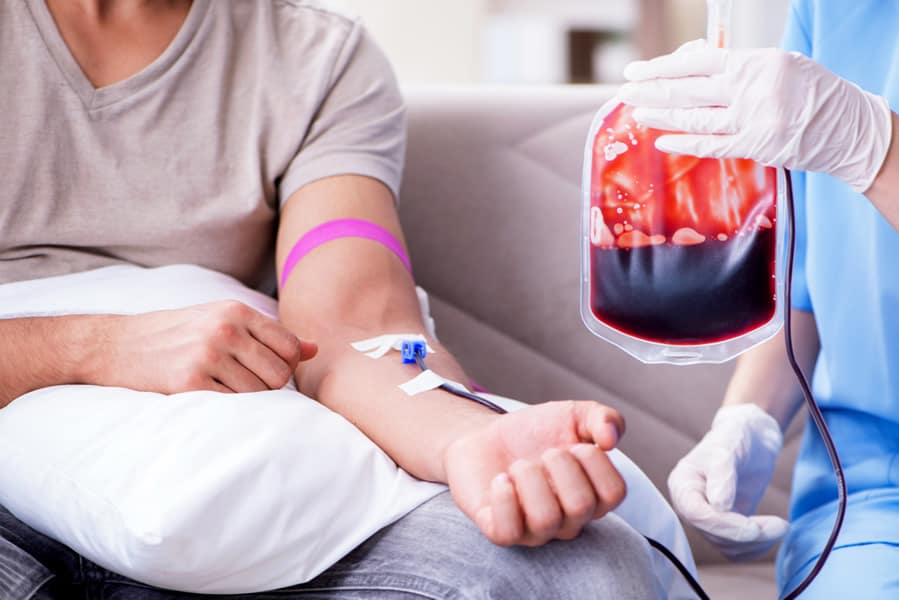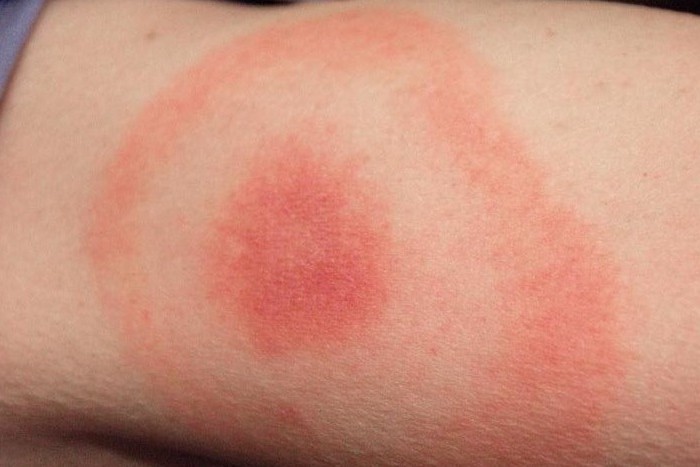At Grace Medical, we perform ozone therapy. First, some background on Ozone.
Ozone is a gas that has three oxygen atoms (O3,) in the molecule. Ordinary oxygen that we breathe is O2, meaning it has two oxygen atoms in its molecule. The combination of atomic oxygen with O2 produces ozone in the atmosphere. Ozone is produced for medical use by ozone generators that pass electrical charge over oxygen thereby generating ozone that is changing O2 to O3.
History of Ozone
Christian Friedrich Schönbein discovered ozone in 1840. Ozone has been used for more than 150 years. Ozone therapy was accepted medicine in the USA from about 1880 until 1932, a period of fifty-two years. Many prominent physicians used ozone to treat a wide variety of medical conditions.
In 1904 a book published on the use of ozonated water and olive oil had the approval of the US Surgeon General.
In 1930 The Journal of The American Medical Association published an article called: The Therapeutic Use of Oxygen in Coronary Thrombosis.
In 1931 Dr. Otto Warburg won the first Nobel Prize for work proving cancer is caused by a lack of oxygen in the cells. He states in “The Prime Cause and Prevention of Cancer” that the cause of cancer is no longer a mystery, we know it occurs whenever any cell is denied 60% of its oxygen requirements. This occurs through a buildup of pollution or toxicity within and around the cell which blocks and then damages the cellular oxygen respiration mechanism.
What does Ozone do inside the body? Ozone has been shown to be highly germicidal in that it will almost instantly kill virtually all viruses, bacteria, fungi, parasites, molds, cancer, etc. It is known to oxidize just about all manmade chemicals. Ozone does a lot of things in the body. The following is a partial list.
- Increases active oxygen for use within the body
- Cleans arteries and veins, improves peripheral circulation
- Reduces inflammation
- Inactivates viruses, bacteria, yeast, fungus, and protozoa
- Purifies the blood and lymph
- Normalizes hormone and enzyme production
- Stops bleeding
- Prevents stroke damage
- Improves brain function and memory
- Oxidizes toxins, allowing their excretion
- Chelates heavy metals (works well with EDTA)
- Prevents and reverses degenerative and auto-immune diseases
- Decreases allergic reactions
- Scavenges free radicals
Ozone has been shown to be effective in treating or improving:
Heart and Blood Vessel Diseases
- Peripheral vascular disease (poor circulation) – primary cause of anoxia, leading to neuropathy
- Cerebral vascular disease (stroke and memory loss)
- Cardiovascular disease (heart disease)
- Coronary spasm (angina)
- Cardio conversion (heart stopped)
- Cardiac arrhythmias (irregular heartbeat)
- Gangrene (of fingers and toes)
- Raynaud’s disease (“white finger”)
- Temporal arteritis (inflammation of the temporal artery)
- Vascular and cluster headaches
- Diabetic ulcers
- Thrombophlebitis
- Deep Vein Thrombosis
Respiratory Diseases
- Chronic obstructive pulmonary disease
- Emphysema
- Asthma
- Bronchiectasis (dilatation of bronchus or bronchi)
- Pneumocystis carinii (PCP or AIDS-related pneumonia)
- Chronic bronchitis
- Tuberculosis
- Sinusitis
Infectious Diseases
- Lyme Disease
- Influenza
- Herpes zoster (shingles)
- Herpes simplex (fever blister)
- Systemic chronic candidiasis (candida)
- Epstein-Barr virus (Chronic Fatigue Syndrome)/Mononucleosis
- HIV-related infections
- Acute and chronic viral infections
- Chronic unresponsive bacterial infections
- Pneumonia
- Wound infections
- Peritonitis
- Furunculosis
- E-coli infections
- Necrotizing infections
Auto-Immune Disorders
- Multiple sclerosis
- Rheumatoid arthritis
- Diabetes mellitus Type II
- Hypersensitive reactions (environmental & universal reactors)
- Fibromyalgia
- Lupus
- Raynauds disease
- Scleroderma
Eye Diseases
- Retinitis Pigmentosa
- Primary Glaucoma
- Macular Degeneration
- Keratitis
- Optic nerve Dysfunction
Skin Disorders
- Psoriasis
- Non-healing wound
- Severe Acne
- Recurrent skin infections
Joint Conditions
- Knee pain
- Lower back pain
- Shoulder pain
- Hip pain
- Elbow pain
Other Diseases
- Parkinson’s Disease
- Alzheimer’s Disease
- Migraine headaches
- Chronic pain syndromes (due to multiple causes)
- The pain of metastatic carcinoma
- Cancers of many types, including the blood and lymph nodes
- Inflammatory conditions
How does ozone work?
Ozone inactivation of bacteria, viruses, yeast, protozoa, and fungi: Oxidation of phospholipids and lipoproteins disrupts the integrity of the bacterial cell envelope. Ozone inhibits certain stages of bacterial cell growth, damages the viral capsid of viruses, and disrupts virus-to-cell contact via peroxidation.
- Enhancement of circulation: Ozone reduces or eliminates red blood cell clumping, and optimizes surface area, thus increasing oxygen-carrying ability. Tissue oxygenation increases as arterial pressure increases and viscosity decreases. Ozone also oxidizes plaque in arteries, unclogging the blood vessels.
- Oxygen metabolism stimulation: Ozone increases the glycolysis rate of red blood cells which leads to increased oxygen released to tissues. Ozone also stimulates the production of enzymes that act as free radical scavengers and cell wall protectors—glutathione peroxidase, catalase, and superoxide dismutase. Ozone enhances the oxidative carboxylation of pyruvate which activates the Krebs cycle, stimulating ATP production. Prostacyclin, a vasodilator, is also induced by ozone.
- Peroxide formation: Ozone forms hydroperoxides by reacting with unsaturated fatty acids of the lipid layer of cell membranes. Lipid peroxidation products include alkoxyl and peroxyl radicals, singlet oxygen, ozonides, carbonides, carbonyls, alkanes, and alkenes.
- Dissolution of malignant tumors: Ozone inhibits tumor metabolism through oxidation of the outer lipid layer of malignant cells and lyses (breaks) them down. Phagocytes produce H2O2 and hydroxyl to kill bacteria and viruses. Hydroxyl generation by killer cells is essential to their cytotoxic ability.
Clinical Applications of Ozone
- Cardiovascular Diseases
In integrative medicine, which often uses Ethylene diamine peracetic acid (EDTA) and sometimes in combination with Plaquex, is the mainstay of therapy for diseases of the cardiovascular system. Ozone therapy in the form of Major Auto-hemotherapy, has also been reported to be a very effective treatment of coronary artery disease as well as other cardiovascular diseases. The combination of EDTA chelation and ozone therapy produces synergistic effects and is a powerful therapy for these diseases. Ozone increases oxygen utilization in heart cells. EDTA provides anticoagulant effects while ozone increases oxygen delivery to the cells. Both decrease vasospasm and they eliminate vulnerable plaque. - Stroke
By virtue of its excellent oxygen delivery ability, ozone is particularly suited for reversing the effects of stroke or impending, evolving stroke. - Eye Problems
Ozone therapy has been shown to be effective in various eye conditions like macular degeneration and glaucoma. - Micro-Vascular Disease and Gangrene
If ischemic conditions have not already progressed into necrosis, the likelihood of saving a limb is very possible. If not possible due to established necrosis, treatment could allow the patient to undergo a lesser amputation. The subsequent difference in quality of life between amputations above versus below the knee is substantial. Chelation-Ozone therapy is not only effective in restoring oxygen to ischemic tissues but also antiseptic with the ability to improve chronic and resistant osteomyelitis. - Ageing
Ageing can be considered a collection of conditions of decreased or poor oxygen utilization and delivery. There is also decreased metabolism and impaired circulation. Ozone is effective in these conditions.
Malignancies
According to the National Cancer Society’s website, the death rate from stage four cancers has not decreased since 1950, when chemotherapy was rarely used. The conclusion overall is that chemotherapy is largely ineffective in many cases of advanced cancer. Cancer is a complex disease therefore its treatment should be comprehensive. Oxygen utilization and the viability of the immune system must be at a maximum. Ozone therapy is well suited for this as it maximizes oxygen utilization, and is a potent immune system stimulator, and improves overall vitality. However, ozone therapy cannot be considered a primary treatment for cancer. As radiation therapy and chemotherapy utilize oxidant stress as a primary cytotoxic mechanism and as ozone results in increased oxidant stress, this makes it a powerful addition to the armamentarium in the fight against cancer.
Chronic Infections
Ozone has been used with great success in cases of Lyme Disease, Hepatitis C, hepatitis B, and Herpes simplex infections.
Auto-Immune Disorders
Ozone has shown effectiveness in ameliorating the debility of many auto-immune conditions including Multiple Sclerosis; Lupus, chronic fatigue syndrome, scleroderma, and rheumatoid arthritis.
Safety of Ozone
The proper medical use of ozone is completely safe. Ozone enhances the body’s systems by cleaning out waste and providing oxygen. It is a natural treatment with high efficiency and no side effects. In a survey of German ozone therapists, 5,579,238 ozone treatments on 384,775 patients displayed a side effect rate of a mere 0.0007% that was uniformly minor and not remotely life-threatening.
How is ozone administered?
Ozone should always be administered by a licensed physician.
- Intravenous injection – A direct injection of ozone gases into the vein
- Intra-articular injection – A direct injection into the painful joint
- Direct injection (into a tumor) – Ozone gas can be injected into a tumor or a cyst
- Autohemotherapy – 50-200ml of blood is drawn, infused with ozone, and transfused back to the patient
- Intracutaneous blistering – Ozone injected into the skin
- Intramuscular – A direct injection of ozone into the muscle
- Subcutaneous – An injection of ozone gas performed just under the skin
Ozone treatments are usually tailored to the individual clinical condition being treated Therefore, dosages, methods of administration and treatment intervals vary from situation to situation of the common ways that ozone can be administered are:
Major Autohemotherapy (mixing ozone with blood and re-infusing) Blood (40 – 200ml) is taken from the patient and 5% ozone gas to 95% medical oxygen (an equal amount) is added. It is then re-infused back to the patient. 2-10 treatments 3 days apart at first then spaced further apart.
Minor Autohemotherapy
Blood (3-5 cc) is taken from the patient and 50-70 gamma (3-5cc) is added the mixture is shaken (succussion) and re-injected intramuscularly. Vaccine-like response from the body. Dissolved in IV fluid solutions (saline or distilled water) Intestinal insufflations (rectal & vaginal) OOT – (ozone/oxygen therapy) is another name for ozone therapy. 100-800 ml of ozone gas (20-50 gamma) is infused into the patient. The best and most tested treatment is 20 days in a row and then 3 weeks off. Not as tested but effective is two treatments per week. Insufflation bags and a common catheter are used for this procedure. Syringes can also be used with a 12-14 inch catheter.
- Auricular insufflations
- Limb bagging
- Topical exposure (ozonated olive oil)
- Joint or subcutaneous injections (Prolozone)
What is Prolozone Therapy?
Prolozone is a homeopathic/oxygen injection technique developed and pioneered by Dr. Shallenberger. Prolozone is derived from the Latin word Proli which means to regenerate or rebuild, and the word ozone. Prolozone uses the power of oxygen to cause damaged tissues, joints, ligaments, and tendons to regenerate. It is excellent for all forms of musculoskeletal and joint pain.
Blood was drawn from a patient’s arm into a 60 ML syringe before the addition of ozone.

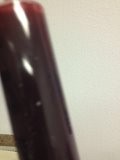
Same blood after the addition of ozone.
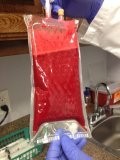
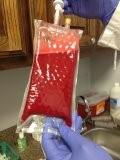
References:
- “Flood Your Body with Oxygen” by Ed McCabe
- J Nat Sci Biol Med. 2011 Jan;2(1):66-70. doi: 10.4103/0976-9668.82319. Ozone therapy: A clinical review. Elvis AM(1), Ekta JS. (1) Vivekananda Education Society’s, College of Pharmacy, Mumbai, India. PMCID: PMC3312702 PMID: 22470237 [PubMed]
- Med Hypotheses. 1992 Sep;39(1):30-4. Ozonization of blood for the therapy of viral diseases and immunodeficiencies. A hypothesis. Bocci V.
- Preliminary Results of Ozone Therapy as a Possible Treatment for Patients with Chronic Hepatitis C Saad Zaky, Sherif Ebrahiem Kamel, Magda Shahata Hassan, Nadia Abdel Sallam, Mohamad Ahmad Shahata, Shaaban Redwan Helal, and Heba Mahmoud. The Journal of Alternative and Complementary Medicine. March 2011, 17(3): 259-263. doi:10.1089/acm.2010.0016. Published in Volume: 17 Issue 3: March 20, 2011

